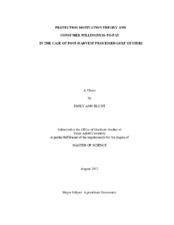| dc.description.abstract | Gulf oysters are harvested and consumed year-round, with more than 90% consumed in a raw, unprocessed state. A chief concern of policymakers in recent years is the incidence of Vibrio vulnificus infection following raw seafood consumption. V.vulnificus refers to a halophilic bacterium naturally occurring in brackish coastal waters, which concentrates in filter-feeding oysters. Proposed FDA legislation requiring processing of all raw Gulf oysters sold during warmer summer months threatens the Gulf oyster industry, as little to no research regarding demand for post-harvest processing (PHP) has preceded the potential mandate.
This research endeavors to examine the relationship between oyster consumers' fears of V.vulnificus infection and their willingness-to-pay (WTP) for processing of an oyster meal. The psychological model of Protection Motivation Theory (PMT) is employed alongside the economic framework of contingent valuation (CV) to result in an analysis of oyster processing demand with respect to threats and efficacy. A survey administered to 2,172 oyster consumers in six oyster producing states elicits projected consumption and PMT data. Principal Component Analysis is used to reduce the number of PMT variables to a smaller size, resulting in five individual principal components representing the PMT elements of source information, threat appraisal, coping appraisal, maladaptive coping, and protection motivation. Using survey data, the marginal willingness-to-pay (MWTP) for PHP per oyster meal is also calculated, and the five created PMT variables are regressed on this calculation using four separate OLS models.
Results indicate significant correlation for four of the five created PMT variables. In addition, a mean MWTP for PHP of $0.31 per oyster meal is determined, contributing to the demand analysis for processing of Gulf oysters. The findings suggest a strong relationship between the fear elements and the demand for processing, and support arguments in favor of further research on specific PHP treatments and the necessity for a valid PMT survey instrument. | en |


